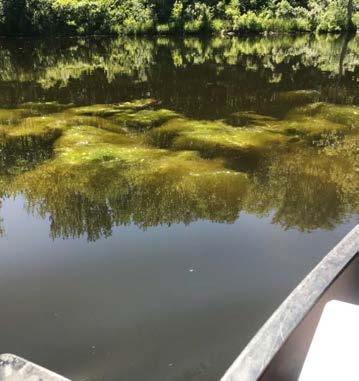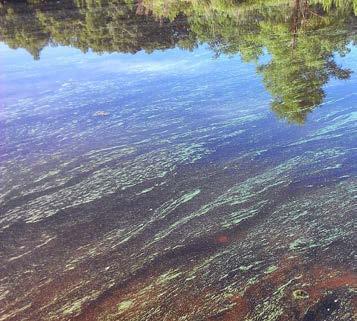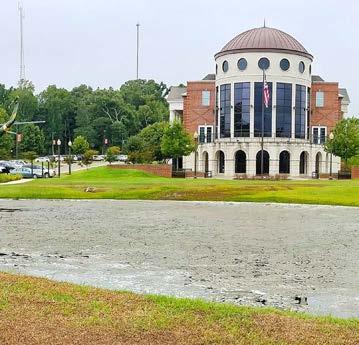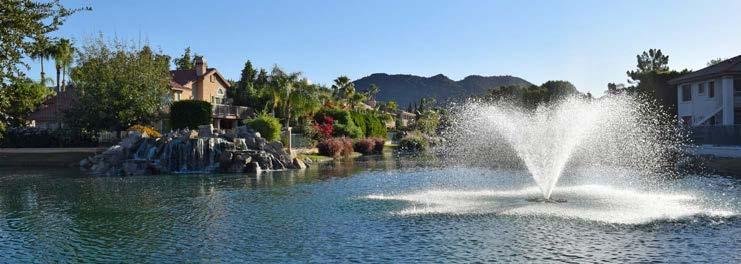
4 minute read
What Is the Cause of Murky Lake Water?
By Trent Nelson, Aquatic Specialist at SOLitude Lake Management
When most people envision their dream waterbody, they picture blue, crystal-clear water that provides a beautiful backdrop for swimming, fishing, or connecting with nature. Unfortunately, visually stunning lakes and ponds aren’t always easy to achieve without consistent management. In fact, murky, turbid, or cloudy water is a common reason homeowners associations, golf courses, public parks, commercial developments, and private property owners seek professional management solutions. To address this issue, it’s important to first understand the root causes.
Advertisement
Murky or Cloudy Pond Water Can Lead to Big Issues
Murky or cloudy water is often a sign of suspended sediment due to erosion, pollution, and stagnation that is hospitable to nuisance mosquitoes, weeds, and “rotten egg” like odors. These signs indicate muck buildup at the bottom of the waterbody. Bottom muck accumulates as a result of inhibited decomposition of materials like plants, algae, and other organic substances (e.g., lawn clippings and fertilizers that have washed in over time). It can also be caused by the presence of invasive species like armored catfish, which burrow into shorelines to breed and lay eggs. Oxygen-rich waterbodies are capable of efficiently processing this sludge, but when oxygen is deficient, muck can accumulate faster than it can be broken down.
Certain pond algae species can create the appearance of murky water, particularly when they accumulate on one side of a lake or pond.
Solutions for Increasing Dissolved Oxygen Levels
There are many ways to increase dissolved oxygen levels in your lake or pond. Floating fountains circulate and aerate the water near the surface while submersed aerators integrate oxygen and movement from bottom to top. Though effective at restoring balance throughout the water column by creating conditions that are less hospitable to plant and algae growth, these types of solutions are limited to targeting muck directly. However, exciting new innovations like Oxygen Saturation Technology (OST) are capable of injecting pure oxygen directly into muck and sludge to expedite its degradation. OST can also distribute oxygen into specific areas in the waterbody for highly targeted oxygen saturation in spaces that need it most.

Shoreline Stabilization Is Key
Likewise, steps should be taken to prevent future erosion around the waterbody. Introducing native, deeprooted buffer plants can help contain the sediment and filter the polluted runoff that flows into the water during rainstorms. More significantly, weakened banks can be stabilized using modern shoreline restoration techniques. A patented knitted mesh solution called SOX Erosion Solutions completely reshapes and anchors the sediment for long-lasting durability. Once in place, the SOX can be planted with sod and beautiful beneficial plants for seamless integration into the surrounding property.
Pairing Hydro-Raking With Shoreline Restoration Services: What Is Hydro-Raking?
In many cases, shoreline restoration services are paired with hydro-raking. A hydro-rake is a floating barge equipped with a backhoe that physically scoops hundreds of pounds of muck and debris from the bottom and deposits it on shore for reshaping or removal. Before hydro-raking can take place, aquatic specialists often complete bathymetric studies. Bathymetry is the process of mapping the bottom of a lake or pond to precisely identify its unique contours and determine the areas most affected by sediment buildup.
Is Your Cloudy Water Due to Planktonic Algae?
Water murkiness is not always a result of muck or suspended sediment. Water can also appear murky due to the presence of planktonic algae, which are microscopic organisms that create visually dense blooms on the water’s surface. Planktonic algae are known to be blue, green, brown, and red in color and are most apparent around the shoreline. Similar to bottom muck, the high concentrations of these algae

Nutrient remediation products can be applied to help prevent the development of nuisance algae blooms. Floating fountains can help circulate and oxygenate the water to help prevent murkiness and bad odors.


Before and after: EPA-registered herbicides or algaecides may be necessary to manage poor water quality conditions.
are typically a result of poor oxygen concentrations and high levels of nutrient pollution.
Phoslock and Alum Treatments Can Balance Water Quality
Aeration is helpful in preventing the accumulation of undesirable blooms, but this solution should also be supported by services like nutrient remediation. When strategically applied to a lake or pond, products like Phoslock and Alum bind to excess nutrients to prevent them from fueling the growth of nuisance algae. Because some species of planktonic algae produce dangerous toxins that are known to harm humans and kill dogs and wildlife, algaecide applications may also be used to swiftly eradicate the blooms.
Remember, Your Waterbody Is Unique
It’s important to remember that every waterbody is different, and every property owner has different goals for their water resources. This means that crystal clear water is not the right outcome for everyone. Productive fisheries, for instance, require water that is rich in nutrients to encourage the growth of impressive largemouth bass and other game fish. Stormwater management ponds can also have different priorities. This is why it’s extremely important to discuss your dreams and expectations before implementing management practices. No matter your goal, your aquatic specialist will help you design a custom roadmap that helps you achieve it.





